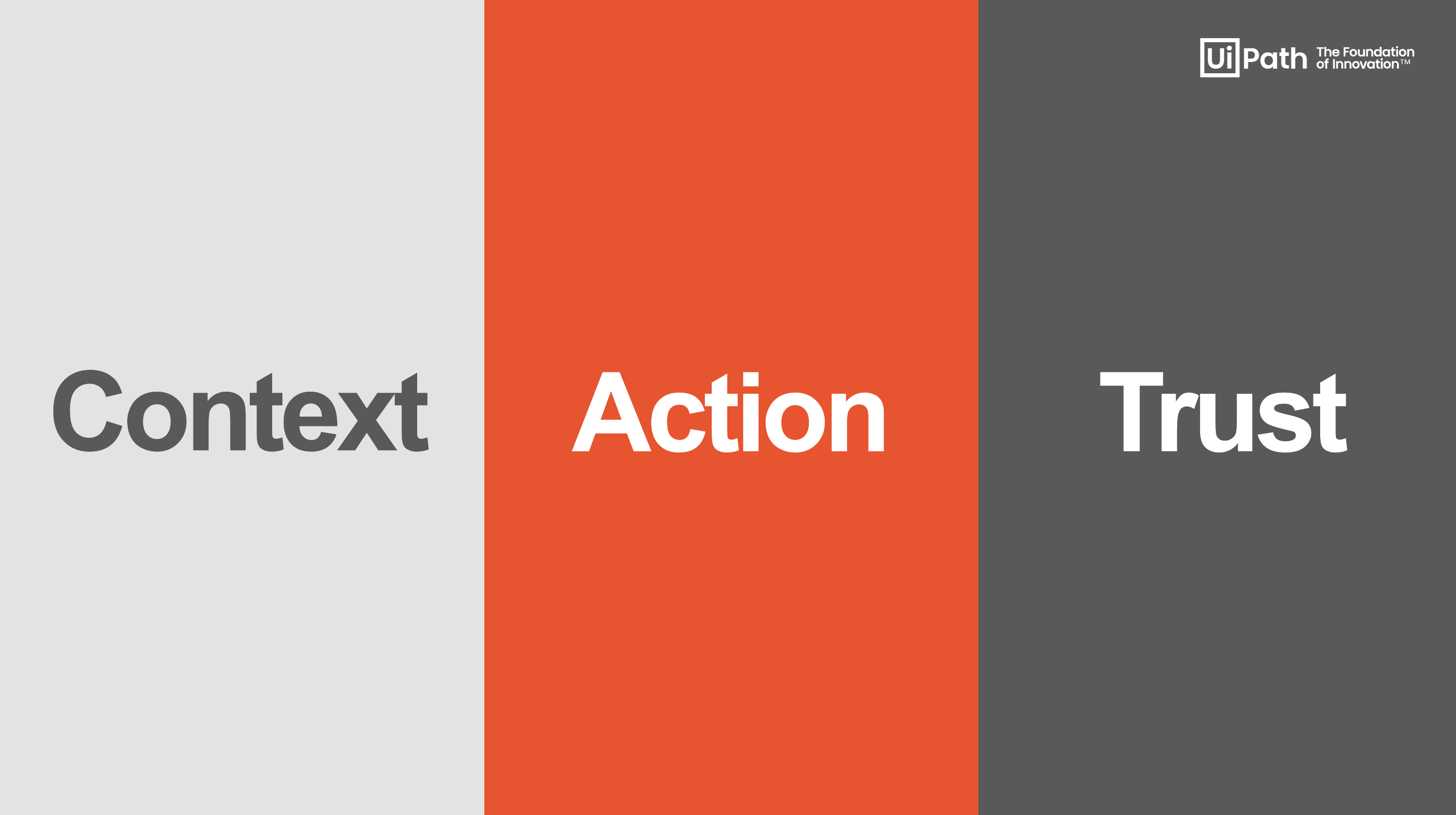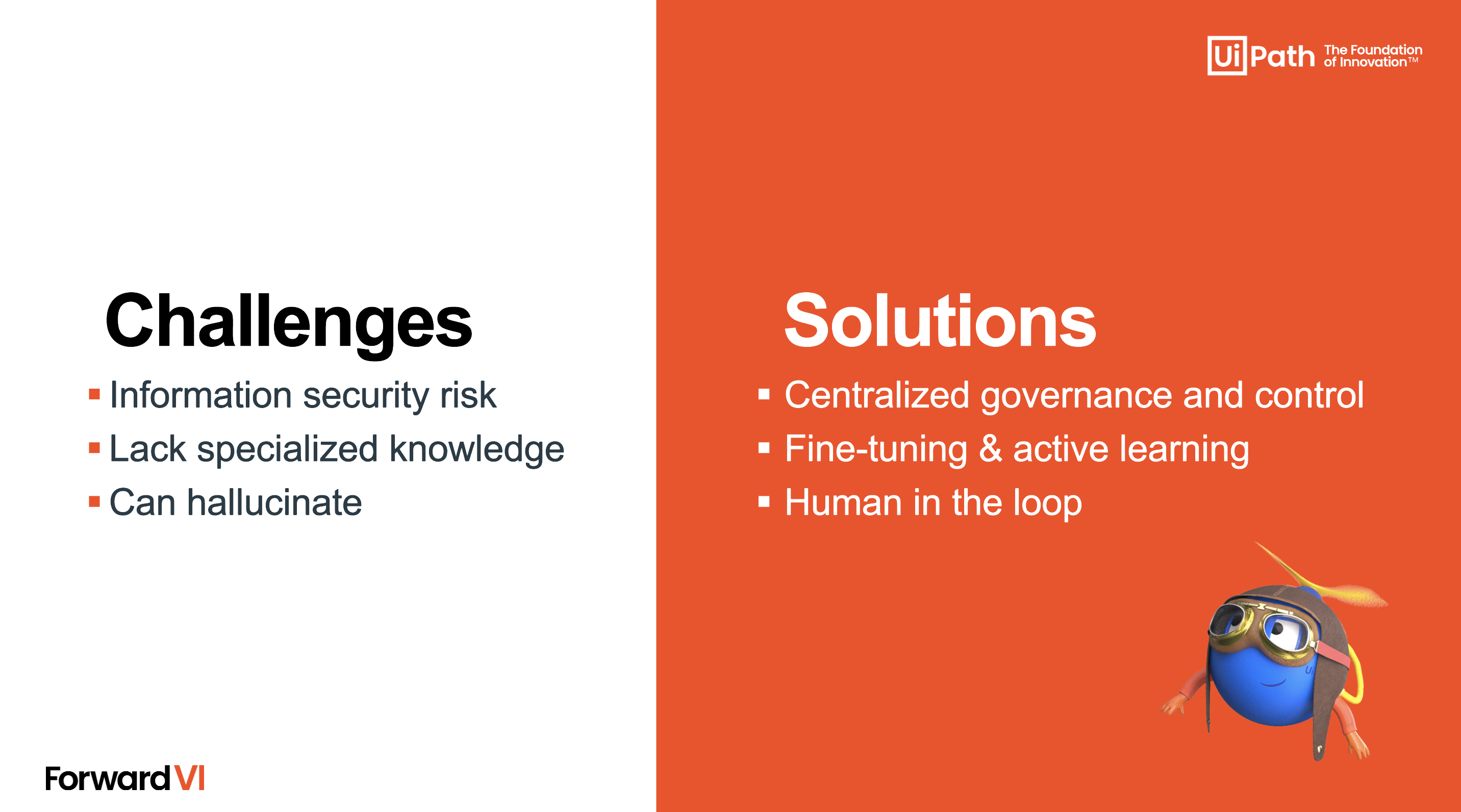Generative AI has sparked one. Increase personal productivityHelping us do all sorts of things more efficiently. Yet, in the enterprise, that productivity has hit a wall. While business leaders are eager to deploy AI in their companies, a number of challenges, particularly around trust, are giving them pause. In a Workday survey of more than 2,300 business executives, 43% of respondents “Concerned about reliability of AI and ML.”
Fortunately, new developments are helping companies overcome these obstacles and pave the way for enterprise-wide productivity improvements.
Meanwhile, these developments were discussed in detail. “The UiPath Blueprint for AI at Work” keynote On the forward VI. The keynote featured AI experts Professor David Barber, Director of the UCL Center for Artificial Intelligence and UiPath Distinguished Scientist, Dr. Ed Challis, Head of AI Strategy at UiPath, and Luke Palmara, VP of AI Product Management at UiPath.
The experts gave an interesting talk on the history of AI and its implications. Latest developments Meaning for enterprise users.
The era of AI
As AI has dominated the headlines, many believe that it is a brand new technology. However, researchers have been working on it for at least half a century. And, according to Barber, “the desire has always been to make these systems work like humans can.”
To get closer to replicating human intelligence, researchers have, in recent decades, built artificial neural networks that mimic how our brains work.
The idea made sense, but figuring out how to connect artificial neural networks “is a very complex problem,” Barber said. “The amount of computation… and the amount of data you need to determine these connections is very, very difficult. So, while the field has been around for a long time, it’s relatively recent,” he explained. That we’ve seen rapid progress in the sense that these systems are becoming very, very useful.
This rapid development came in 2012 with a wide variety of graphics processing units (GPUs). GPUs have provided a much-needed increase in processing power that has greatly accelerated the time it takes to train AI.
As the graph above shows, today’s GPU-powered AI outperforms the average human in object recognition, speech, and even reading comprehension. But these cognitive functions are only half of what makes human intelligence so profound.
Making AI a partner rather than just an advisor
As AI’s cognitive abilities grew, researchers began to explore its creative potential. In 2019, they had the bold idea to train an LLM on a huge chunk of the Internet and ask the LLM to generate the next word in a sentence.
As we have seen. LLMs like ChatGPT, the results have been surprising. These systems don’t just generate code or snippets of text—given the vast linguistic data available online, they’ve achieved a depth of cultural understanding previously thought unattainable.
But while the creativity of these systems is amazing, they are far from perfect.
The good thing is. [LLMs] are built like the human brain…so they are good at cognitive tasks. The bad thing is that they are designed like the human brain in the sense that they are also fallible.
David Barber, Director of the UCL Center for Artificial Intelligence and UiPath Distinguished Scientist
Understanding when we can trust AI, and when we can’t, is a huge roadblock to wider enterprise adoption (more on that soon).
Current AI Challenges
When it comes to today’s enterprise AI, “things are kind of distributed,” according to Palmara.
On the one hand, you have Special AIHighly optimized models that are fast, cheap, and have a detailed understanding of business data. They are highly effective in specific tasks, such as extracting information from communications and documents, including invoices, bills and receipts. However, they are less efficient when faced with conflicts other than trained examples.
Then you have the LLMs, which underpin generative AI. They are extremely powerful, but mainly for individual tasks such as summarizing information, analyzing data, etc. They also have other limitations, such as providing false information.
For AI to move beyond personal tasks and increase enterprise productivity, it needs to be more than an advisor—it needs to actually do the work. How can we make it real?
According to Palmara, there are three main components.

idea, context
“AI is only as good as you make it. Even if you have the best customer service agent in the world, they won’t be able to help customers if they don’t know company policies,” Palmara said. Is.
There is a way to come up with this, within the UiPath Business Automation Platform. UiPath Integration Service. It acts as a bridge between AI and related data sources, giving AI the context it needs to operate.
the process
“What’s knowledge if you can’t practice it?” Palmara asked the crowd. To be productive at the enterprise level, AI needs to do more than generate text and images. It needs to perform tasks such as transferring data between systems, responding to customers and placing orders automatically.
That’s what UiPath is all about… it’s about putting AI to work. It’s about bringing that rich set of capabilities that allow AI to take action and not just be an advisor.
Luke Palmara, VP, AI Product Management, UiPath
Trust
Many company leaders are eager to embrace AI, but do not yet have a sufficient level of trust in it. “Trust is the foundation. If we can’t trust these systems, ultimately we can’t use them,” Dr. Challis said.
Dr. Challis described three primary challenges standing in the way of trusting AI: information security, lack of specialized knowledge, and illusion.

UiPath is working hard to address these challenges. new UiPath AI Trust Layer The model provides transparency, admin controls, and usage auditing to assure users that their data is secure in UiPath applications.
There are a few ways to overcome the lack of specialized knowledge. First, you can give accurate clues. “UiPath is very strong in getting this information into the LLM,” said Dr. Challis.
You can also fine-tune models with special information. This has historically been expensive, but active learning is a new way to train models more efficiently.
How active learning improves performance.
Essentially, active learning enables AI to recommend its own algorithms instead of relying on manual data labeling. For example, traditionally, training a model for cat recognition requires manually labeling cat images. However, with active learning, AI can learn by itself to recognize a cat in an image and validate its identity with human feedback, greatly reducing the bottleneck of manual data labeling.
Replace cats with documents, and the enterprise value becomes clear. Dr. Challis said that he “looks at active learning almost as a conversation between two peers. You just ask questions about things you’re not sure about, you ask the same question over and over again. Don’t ask.
AI still needs a human in the loop.
As powerful as AI is with active learning, it still needs a human to ensure trust and accuracy. Having a human in the loop is “one of the most important capabilities when it comes to making enterprise AI productive in business,” Palmara said.
While correcting mistakes is an important human task, they also build trust. That’s why we’ve built the UiPath Action Center to allow humans to approve AI decisions and override them when necessary.
The road ahead for AI
Dr. Challis concluded the session by asking Barber what he expects from AI in the next several years. Barber expects her to improve in logic and calculation, which, when combined with her current abilities, will be “a giant step forward for humanity”.
While AI has its fair share of problems, Dr. Challis reminded the audience that “we have the components to make it safe, to make it responsible, to make it manageable. The onus is on us.” That we build the systems on which we want to base our business.
Read related.: Top 5 AI Announcements by UiPath FORWARD VI
Get the best of FORWARD VI delivered to your inbox when you Register for the ‘Best Bits’.













